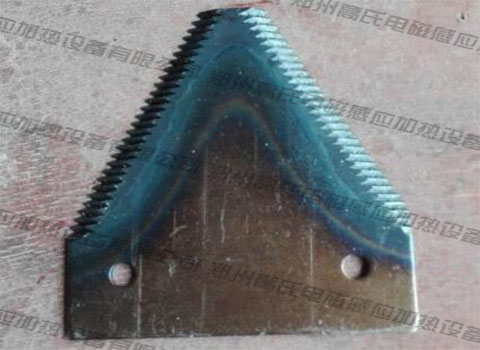After the mechanically processed blade is heat-treated in an intermediate frequency induction heating furnace, it needs to be inspected in terms of hardness and straightness to see if the blade meets its heat treatment technical requirements. According to strict process parameters, if the blade of the harvester If the hardness and straightness are unqualified, it needs to be annealed first, and then quenched again, so as not to increase the stress of the blade and cause the blade to crack. Although we operate carefully throughout the heat treatment process, there are still factors such as material, operation, and environment that affect the quality of the blade after heat treatment.
1. The teeth of the blade will be broken in small pieces. This is because the hardness of the blade is too high and the brittleness is too high. When it encounters hard objects, it will produce fragments. It may also be that the blade of the harvester has not been tempered in time after quenching. lead to excessive stress. In this regard, we must operate in strict accordance with the standard requirements when performing heat treatment. The blade should be tempered in time after quenching to keep its hardness within an appropriate range and avoid being too large or too small.
2. The edge curling of the blade is due to the hardness of the tooth edge of the blade is too low, the heat treatment process of the intermediate frequency induction heating furnace is not appropriate, the selection of raw materials is not suitable or the strength of the raw materials is low. In this regard, we must carefully implement the established process parameters, and conduct quality inspections on the materials and heat-treated blades to ensure that they are qualified.
3. The blade is severely worn. This is because the hardness of the tooth edge is too low, and when it collides with hard objects, the abrasive grains of the blade are worn. In this regard, it is necessary to operate in accordance with the standard process requirements, improve the hardness of the blade after heat treatment, clean up the hard objects in the soil in time, and reduce the collision between objects.
4. The tooth root of the blade has continuous broken teeth. This is due to the collision with hard objects in the soil during the working process. After heat treatment, the stress at the tooth root is relatively concentrated, with high hardness and low toughness. Small impact Too many times can cause broken teeth. In this regard, when working, it is necessary to clean up the stones and hard objects in the soil around the blade in time, adjust the distance between different types of blades, avoid collisions between the two, and temper them in the intermediate frequency induction heating furnace The processing should be sufficient so that the hardness of the blade reaches the required range.
5. There are gaps on the blade and cracks on the surface. This is caused by the collision between the blade of the harvester and hard objects such as stones. The hardness of the blade is too high, which exceeds the standard requirements. In the end, it was not fully tempered, and tempered The time is short, resulting in too much internal stress. In this regard, it is necessary to strictly implement the technical requirements of heat treatment, and carry out sufficient tempering treatment to ensure that the temperature and time are within the appropriate range.




 en
en  cn
cn  jp
jp  ko
ko  de
de  es
es  it
it  ru
ru  pt
pt  vi
vi  th
th  pl
pl 







 GS-ZP-1200
GS-ZP-1200


